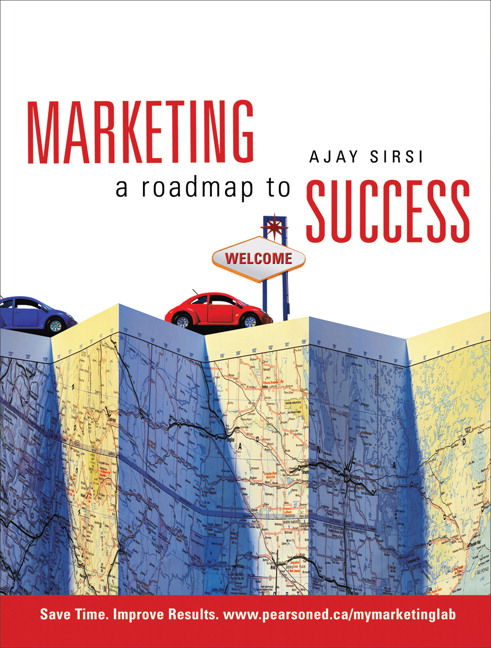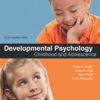Test Bank for Marketing: A Roadmap to Success Ajay K. Sirsi
$35.00 Original price was: $35.00.$26.50Current price is: $26.50.
Test Bank for Marketing: A Roadmap to Success Ajay K. Sirsi
Test Bank for Marketing: A Roadmap to Success Ajay K. Sirsi

Product details:
- ISBN-10 : 0137138121
- ISBN-13 : 978-0137138128
- Author: Sirsi, Ajay K
Description:
CHAPTER 2
Understanding Customer Needs
MULTIPLE CHOICE
1. Companies that try to push a good or a service on customers are destined to fail without a proper understanding of
a. the competition.
b. media planning.
c. customer needs.
d. advertising research.
e. the marketing mix.
Answer: c Difficulty: easy Page: 25 Skill: recall
Learning objective: 2-1
2. When the sales department drops prices to secure a contract, while the marketing function is trying to build the brand and maintain price premiums, the brand is
a. more competitive.
b. using a pull strategy.
c. using a push strategy.
d. devalued in the marketplace.
e. number one in the marketplace.
Answer: d Difficulty: moderate Page: 26 Skill: applied
Learning objective: 2-1
3. In organizations where there is no clear and widely shared understanding of customer needs
a. all functions are integrated.
b. operations are streamlined.
c. departments have multiple responsibilities.
d. the marketing direction is determined by the sales function.
e. each function does its own thing.
Answer: e Difficulty: easy Page: 26 Skill: applied
Learning objective: 2-1
4. An accurate understanding of customer needs allows a company to
a. create customer value.
b. meet financial objectives.
c. respond to competitive threats.
d. perfect advertising messages.
e. develop media plans.
Answer: a Difficulty: moderate Page: 27 Skill: recall
Learning objective: 2-1
5. Companies that do not understand their customers are likely to
a. spend less on advertising.
b. maintain price premiums.
c. have synergy among all their functions.
d. create customer value.
e. focus solely on the technology.
Answer: e Difficulty: moderate Page: 28 Skill: recall
Learning objective: 2-1
6. Southwest Airlines’ decision to focus on the customer segment that does not want frills, only low fares, demonstrates the firm’s deep understanding of
a. customer needs.
b. economies of scale.
c. advertising.
d. public relations.
e. the competition.
Answer: a Difficulty: easy Page: 29 Skill: applied
Learning objective: 2-2
7. When Sony targeted the Walkman to joggers who would appreciate the break from a tedious activity, the company was
a. conducting research.
b. narrowcasting.
c. repositioning the product.
d. creating a customer need.
e. trying out various sales strategies.
Answer: d Difficulty: moderate Page: 31 Skill: applied
Learning objective: 2-3
8. Danone created a new market for its Danone Actimel yogurt by
a. focusing on a specific audience segment.
b. increasing advertising spending.
c. expanding distribution.
d. using just a health appeal in their advertising.
e. combining health benefits and taste.
Answer: e Difficulty: challenging Page: 31 Skill: applied
Learning objective: 2-3
9. Research that has already been conducted by someone else is referred to as
a. primary research.
b. secondary research.
c. qualitative research.
d. quantitative research.
e. a survey.
Answer: b Difficulty: easy Page: 33 Skill: recall
Learning objective: 2-4
10. Qualitative techniques include
a. ethnography.
b. mall intercept surveys.
c. telephone surveys.
d. online questionnaires.
e. secondary research.
Answer: a Difficulty: challenging Page: 33 Skill: recall
Learning objective: 2-4
11. A guided discussion with a group of respondents such as customers is referred to as
a. participant observation.
b. a group survey.
c. an in-store survey.
d. a depth interview.
e. a focus group.
Answer: e Difficulty: moderate Page: 33 Skill: recall
Learning objective: 2-4
12. Before conducting primary research, this technique can help identify gaps in knowledge and what traps to avoid.
a. focus groups
b. secondary research
c. ethnographies
d. depth interviews
e. exploratory research
Answer: b Difficulty: moderate Page: 33 Skill: recall
Learning objective: 2-4
13. An advantage of secondary research is that
a. you conduct the research yourself.
b. it takes longer than primary research.
c. it can be expensive.
d. you may find the answer you are researching.
e. there are few sources of secondary data.
Answer: d Difficulty: easy Page: 33 Skill: recall
Learning objective: 2-4
14. Common sources for secondary research include
a. focus groups.
b. depth interviews.
c. ethnographies.
d. company employees.
e. professional associations.
Answer: e Difficulty: easy Page: 33 Skill: recall
Learning objective: 2-4
15. A caution you should heed when conducting secondary research is that
a. the research may be biased.
b. it is relevant to your marketing problem.
c. published sources are always reliable.
d. all research objectives are similar.
e. most research is current.
Answer: a Difficulty: moderate Page: 33 Skill: recall
Learning objective: 2-4
16. The main goal of primary research techniques is to
a. identify gaps in knowledge.
b. explore the dimensions of a problem and generate ideas.
c. learn what traps to avoid.
d. determine research objectives.
e. gather customer insights from databases.
Answer: b Difficulty: moderate Page: 33 Skill: recall
Learning objective: 2-4
17. Focus groups are conducted
a. online.
b. in shopping malls.
c. over the phone.
d. by a moderator.
e. by a secondary research source.
Answer: d Difficulty: easy Page: 34 Skill: recall
Learning objective: 2-4
18. Focus groups allow clients to
a. test marketing communications messages.
b. interact directly with customers.
c. gather quantitative data.
d. ensure the moderator follows the guide.
e. gather research for free.
Answer: a Difficulty: moderate Page: 34 Skill: applied
Learning objective: 2-4
19. If Kodak wanted to test its customers’ reaction to a new digital camera innovation, which research methodology would be best suited to this?
a. mall intercept surveys.
b. telephone surveys.
c. online questionnaires.
d. depth interviews.
e. focus groups.
Answer: e Difficulty: challenging Page: 34 Skill: applied
Learning objective: 2-4
20. A data collection method where the moderator engages one respondent in a conversation for at least 60 minutes is referred to as
a. a depth interview.
b. a focus group.
c. an online survey.
d. a telephone survey.
e. an in-store survey.
Answer: a Difficulty: moderate Page: 35 Skill: recall
Learning objective: 2-4
21. If a company marketing medical diagnostic equipment wants to understand the buying decision-making process, it should conduct research with physicians using which technique?
a. a telephone survey
b. an online survey
c. participant observation
d. a hospital questionnaire
e. a depth interview
Answer: e Difficulty: challenging Page: 35 Skill: applied
Learning objective: 2-4
22. In ethnographies, the researcher becomes
a. the secondary source.
b. the moderator.
c. the customer.
d. the marketer.
e. the interviewer.
Answer: c Difficulty: easy Page: 35 Skill: recall
Learning objective: 2-4
23. A process where the researcher actively participates with the customer to gain insights is referred to as
a. a focus group.
b. a depth interview.
c. a mall intercept survey.
d. secondary research.
e. participant observation.
Answer: e Difficulty: moderate Page: 35 Skill: recall
Learning objective: 2-4
24. DeWalt’s sending researchers to work alongside professionals who work with their tools is an example of
a. a depth interview.
b. a focus group.
c. participant observation.
d. public relations.
e. direct marketing.
Answer: c Difficulty: moderate Page: 35 Skill: applied
Learning objective: 2-4
25. When trying to understand why its customers might tattoo the brand name on their bodies, Harley Davidson might turn to
a. focus groups.
b. ethnography.
c. depth interviews.
d. online surveys.
e. customer satisfaction surveys.
Answer: b Difficulty: challenging Page: 35 Skill: applied
Learning objective: 2-4
26. Quantitative data collection by means of a questionnaire is referred to as
a. a survey.
b. a depth interview.
c. a focus group.
d. participant observation.
e. sales tracking.
Answer: a Difficulty: easy Page: 35 Skill: recall
Learning objective: 2-4
27. All questionnaires include this class of questions.
a. primary
b. secondary
c. product concept
d. demographic variables
e. participant observation
Answer: d Difficulty: moderate Page: 36 Skill: recall
Learning objective: 2-4
28. Unlike qualitative research methods, survey research is used to collect data from
a. a small group of customers
b. a large sample of respondents
c. focus group participants
d. depth interview participants
e. researchers who become the customer
Answer: b Difficulty: easy Page: 36 Skill: recall
Learning objective: 2-4
29. Surveys are not used to generate ideas but to
a. test new product concepts.
b. test key marketing messages.
c. validate ideas.
d. understand the buying process.
e. explore the dimensions of a problem.
Answer: c Difficulty: moderate Page: 36 Skill: applied
Learning objective: 2-4
30. The main problem with using marketing research to understand customer needs is that
a. the research may be biased.
b. the research may be outdated.
c. the research objectives may not match your objectives.
d. customers may not be able to articulate their needs.
e. the moderator may not follow the guide.
Answer: d Difficulty: moderate Page: 37 Skill: applied
Learning objective: 2-5
31. Customers are always able to articulate their needs in terms of
a. their attitudes and feelings.
b. their behaviour.
c. their demographic variables.
d. their psychographic variables.
e. their basic care needs.
Answer: e Difficulty: moderate Page: 37 Skill: recall
Learning objective: 2-5
32. One problem that companies face is that by the time the research takes place,
a. the marketing budget is spent.
b. competitors beat them to the marketplace.
c. the market opportunity may have passed.
d. the secondary research is outdated.
e. the focus group participants are no longer customers.
Answer: c Difficulty: moderate Page: 37 Skill: applied
Learning objective: 2-5
33. Smart companies challenging the product-centric approach to marketing are embracing a method whereby they are
a. co-creating value with their customers.
b. determining what’s best for their customers.
c. conducting secondary research.
d. conducting primary research.
e. becoming the customer.
Answer: a Difficulty: moderate Page: 38 Skill: recall
Learning objective: 2-5
34. By allowing customers to customize their bear and meet an unlimited set of needs, Build-A-Bear is
a. conducting market research.
b. segmenting their target audience.
c. maximizing resources.
d. communicating key messages to customers.
e. involving the customer in the innovation process.
Answer: e Difficulty: challenging Page: 38 Skill: applied
Learning objective: 2-5
35. The medium that allows smart companies to involve the consumer in the innovation process is
a. television.
b. radio.
c. the internet.
d. newspapers.
e. magazines.
Answer: c Difficulty: challenging Page: 39 Skill: recall
Learning objective: 2-5
36. Manufacturers often naively believe that their only competitors are
a. national brands.
b. heavily advertised brands.
c. in the same country.
d. in the same city.
e. in the same industry.
Answer: e Difficulty: moderate Page: 39 Skill: applied
Learning objective: 2-5
37. When FedEx, the overnight package delivery company, bought Kinko’s, the document printing company, they became an example of a company that
a. acts first, then tweaks later.
b. co-creates customer value.
c. treats the whole world as a research firm.
d. looks across the chain of buyers.
e. looks at substitute industries.
Answer: d Difficulty: challenging Page: 40 Skill: applied
Learning objective: 2-5
38. Looking across complementary product and service offerings is one way a company can
a. test new message strategies.
b. test new product concepts.
c. co-create customer value.
d. create new market space.
e. research the competition.
Answer: d Difficulty: challenging Page: 40 Skill: recall
Learning objective: 2-5
39. Most competitors look the same, offer the same value, and commoditize the industry because they
a. offer complementary products.
b. focus on a common set of appeals.
c. focus on different types of buyers.
d. co-create value with the customer.
e. conduct similar research studies.
Answer: b Difficulty: moderate Page: 42 Skill: applied
Learning objective: 2-5
40. Starbucks was able to break free of the price-cutting and promotional norms of the coffee industry by
a. commoditizing the industry.
b. focusing on a common set of appeals.
c. offering complementary products.
d. appealing to an emotional benefit.
e. appealing to price-sensitive customers.
Answer: d Difficulty: challenging Page: 42 Skill: applied
Learning objective: 2-5
41. By offering food services at movie theatre complexes so that patrons can get a meal before the show, movie theatre companies are creating value by
a. considering substitute industries.
b. offering complementary services.
c. targeting multiple audience segments.
d. making an emotional connection with audiences.
e. creating partnerships.
Answer: b Difficulty: moderate Page: 40 Skill: applied
Learning objective: 2-5
42. When Arbol Industries’ sales professionals adopted the practice of visiting their customers at their place of work, they
a. commoditized their products.
b. better understood their customers’ needs and uncovered opportunities.
c. offered complementary products and services.
d. targeted multiple audience segments.
e. developed a “push” strategy.
Answer: b Difficulty: moderate Page: 44 Skill: applied
Learning objective: 2-5
TRUE – FALSE
1. The really smart companies do not merely understand customer needs; they create them.
Answer: True Difficulty: easy Page: 25 Skill: recall
Learning objective: 2-1
2. Companies can only create customer value if they have an accurate understanding of customer needs.
People also search:
marketing strategy roadmap template
marketing roadmap example
marketing strategy roadmap
marketing automation roadmap
how to create a marketing roadmap
a marketing associate is working on a remarketing strategy











